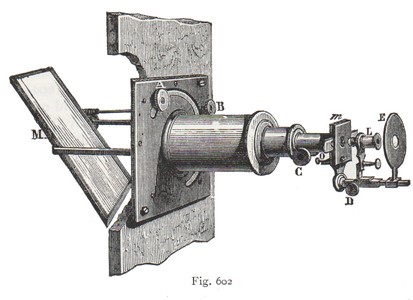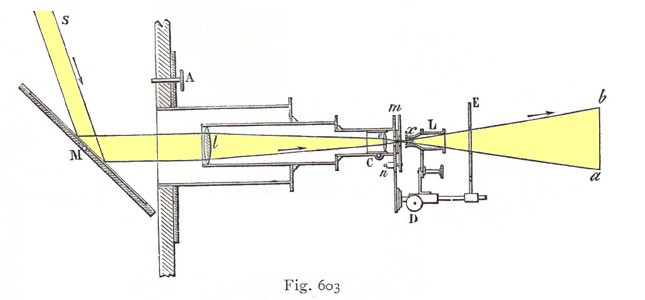





Extracted from the translation of Ganot's Éléments de Physique, 1868 (3rd edition)

Solar microscope.
The solar microscope is a magic
lantern illuminated by the sun's rays which serves to
produce highly magnified images of very small
objects. It is worked in a darkroom : fig. 602
represents it fitted in the shutter of a room, and
fig. 603 gives the internal details.
The sun's rays fall on
a plane mirror, M, placed outside
the room, and are reflected towards a condensing
lens, l, and thence to a
second lens, o (fig. 603),
by which they are concentrated at its focus. The
object to be magnified is at this point; it is placed
between two glass plates, which, by means of a
spring, n, are kept in a
firm position between two metal plates,
m. The object thus strongly
illuminated is very near the focus of a system of
three condensing lenses, x,
which forms upon a screen at a suitable distance and
inverted and greatly magnified image,
ab. The distance of the
lenses o and
x from the object is
regulated by means of screws,
C and
D.
As the direction of the
sun's light is continually varying, the position of
the mirror outside the shutter must also be changed,
so that the reflection is always in the direction of
the axis of the microscope. The most exact apparatus
for this purpose is the heliostat, but as this
instrument is very expensive, the object is usually
attained by inclining the mirror to a greater or less
extent by means of an endless screw
B, and at the same time
turning the mirror itself round the lens
l by a knob
A, which moves in a fixed
slide.
The solar microscope
labours under the objection of concentrating great
heat on the object, which soon alters it. This is
partially obviated by interposing a layer of a
saturated solution of alum, which, being a powerfully
athermanous substance, cuts off a considerable
portion of the heat.
The magnifying power of
the solar microscope may be deduced experimentally by
substituting for the object a glass plate marked with
lines at a distance of 1/10 or 1/100 of a millimeter.
Knowing the distance of these lines on the image, the
magnifying power may be calculated. The same method
is used with the electric light. According to the
magnifying power which it is desired to obtain, the
objective x is formed of
one, two, or three lenses, which are all
achromatic.


The following was extracted from the Lerebours et Secretan Catalogue, 1853

Images projected through the microscope onto a wall and then photographed

Probosics of a Blow Fly

Cross sections of Echinus spines